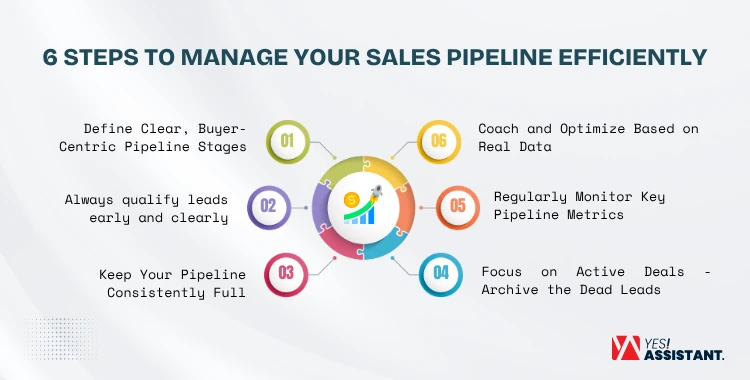
Step-by-Step Guide to Effective Sales Pipeline Management
A well-structured sales pipeline can give you a clear view of where your leads or potential customers are in the buying journey. Having a clearly defined sales pipeline is essential now to estimate revenues. Managing your sales pipeline effectively can increase your conversion rates and revenue massively.
Today, we will learn show you how to manage your sales pipeline efficiently.
What's Inside
What is a Sales Pipeline?
A sales pipeline is the visual representation of where each lead or prospect is in the sales process. It provides a structured way for a sales team to track and manage the progress of leads, making sure they move through the sales process effectively to convert into paying customers.
The sales pipeline focuses on the seller’s journey, showing the steps a sales team takes to engage leads, nurture opportunities, and close deals by converting them. Unlike a sales funnel, a sales pipeline is a tool designed specifically for sales operations.
What is Sales Pipeline Management?
Sales pipeline management is the process of tracking, analyzing, observing, and optimizing how leads or potential customers move through various stages of the sales process. It visualizes the lifecycle of various customer prospects, from initial interaction to closing deals. The goal of sales pipeline management is to convert leads to paying customers and close more deals, and generate more revenue.
Managing the sales pipeline involves visualising the sales process, identifying shortcomings and working on them, and making decisions that can refine the sales process to increase conversion rates and improve overall sales performance. Businesses that master their sales pipeline saw a staggering 28% higher revenue growth!
6 Steps to Manage Your Sales Pipeline Efficiently
You should focus on making your sales pipeline more effective by having clear goals, regular observation, and consistency. However, 63% of respondents say that their companies do a bad job of managing their sales pipelines, which shows that there is massive room for improvement.
The six key steps of managing your sales pipeline effectively are described below:

Step 1: Define Clear, Buyer-Centric Pipeline Stages
At first, you need to define clear, buyer-centric pipeline stages. This involves making a series of defined steps that align with the buyer’s journey, guiding them from initial awareness to final purchase.
By defining these steps, your sales team can understand where a prospect is in the buying process, adjust their approach, close more deals, and increase conversion rates and revenues. Each stage should have clear criteria for progression and measurable actions for sales reps. By defining these stages, you are able to set standards for your leads as well.
Step 2: Always Qualify Leads Early and Clearly
It is important to qualify leads early and clearly in the sales pipeline for efficient resource allocation and successful sales. By identifying and focusing on qualified leads who have higher chances of converting, sales teams can optimize their efforts and avoid wasting time on unqualified prospects.
To use time and resources properly, early and clear lead qualification helps. It involves focusing on high-potential leads, reducing wasted efforts, and shortening the sales cycle length. By this targeted approach, sales efforts are focused on prospects who are most likely to benefit from the product or service. As a result, it creates a more accurate and effective sales pipeline process with fewer gaps. It also improves communication and understanding between the sales team and the leads.
Step 3: Keep Your Pipeline Consistently Full
You need to keep your pipeline consistently full if you want more revenue and conversions regularly. Focus on continuous lead generation, effective pipeline management, and consistent follow-up. This will gradually lead to more profit in your business in the long run.
Know your ideal customer and actively seek out new leads through various channels. You can also use tools to automate lead generation activities for effective customer retention. Monitor lead movement through each stage and analyze where leads are getting stuck or dropping off. By observing this, you can refine your pipeline for more engagement. Also, develop a follow-up strategy, because consistent follow-up engages leads more by reminding them about your product or service’s existence and values.
Step 4: Focus on Active Deals – Archive the Dead Leads
Focus on the leads who are progressing actively and archive the inactive leads. Archiving lets you remove inactive leads and deals from your active view without losing historical data. This helps your sales team concentrate on leads with the highest chances of conversion and improve sales performance.
Active leads are prospects currently engaged in the sales process, showing genuine interest and moving towards a purchase decision. On the contrary, dead leads are prospects who have shown no engagement or interest for an extended period or have shown that they are not interested. Schedule regular reviews of your pipeline to identify and archive dead leads. By getting rid of them and decluttering your pipeline, your sales team will be able to improve their focus, increase efficiency and visibility, and make the sales process more accurate and smooth.
Step 5: Regularly Monitor Key Pipeline Metrics
Sales pipeline metrics are used to monitor, quantify, and measure activities in the different stages of your sales pipeline. By measuring key pipeline metrics like pipeline value, number of opportunities, win rate, sales velocity, conversion rates, etc., you can optimize your sales processes, refine lead generation strategies, and make data-driven decisions to close more deals.
You should monitor your sales pipeline’s metrics regularly to find shortcomings and refine your strategies. It helps you identify the most effective sources and channels to generate and nurture leads. As a result, you are able to make more data-driven decisions to increase conversion rates and ultimately generate more revenue.
Step 6: Coach and Optimize Based on Real Data
Consistently monitor your sales pipeline, understand its health at both the micro and macro levels, use data to drive coaching and process adjustments, and provide targeted solutions to improve performance. Companies that train their sales managers in pipeline management see their revenue grow 9 percent faster than those that don’t.
Track and analyze metrics like win rate, sales cycle length, conversion rates at each stage, pipeline velocity, and lead source effectiveness. This helps you analyze your pipeline health and refine it if necessary. Based on data analysis, provide appropriate coaching to individual salespeople, addressing specific weaknesses and building on their strengths. Schedule regular updates on pipeline performance and progress to keep the team informed and motivated, and refine the sales process and coaching strategies based on data analysis and changing market conditions.
How to Improve Your Sales Pipeline Management?
Your sales pipeline is something you should keep refining continuously, and that requires consistent management. To improve your sales pipeline management, at first, you need to understand each stage of your sales pipeline, ensure consistent communication, make effective strategies, and take data-driven decisions. However, it is best to hire a sales virtual assistant to make your sales pipeline management more professional. Firms with structured pipelines achieved a 16% higher win rate, indicating that a clear and organized pipeline directly contributes to closing more deals.
The key strategies to improve your sales pipeline management are described below:
Defining a Clear Sales Process
Define the stages of your sales pipeline, and map out the stages from lead generation to closing deals. Create a step-by-step process for your sales team to follow, and regularly review and update your sales process to adapt to market changes.
Managing Leads Effectively
Identify the high-quality leads by lead scoring and other methods and monitor them regularly. By doing this, you can keep your pipeline refined and accurate, focus on leads that have the highest chances of conversion, and upgrade your strategies to re-engage inactive leads.
Using Technology/CRM Systems
You can use tools and technology to improve your sales pipeline management. CRM (Customer Relationship Management) provides a centralized location for managing leads, customer interactions, and sales data. It also improves communication and provides insights into your sales pipeline.
Analyzing and Optimizing Strategies
Track key metrics like conversion rates, sales velocity, sales cycle length, etc., to identify where improvement is needed. Identify where the sales process is being disrupted and leads are getting uninterested. Based on your analysis, adjust your sales process, messaging, or lead generation strategies to optimize overall performance.
Final Note
Effective sales pipeline management is the key to a high-performing sales team. It not only helps you stay organized but also helps you take data-driven decisions, increase win rates, and ensure consistent growth. By tracking your leads throughout the sales pipeline, you can turn leads into loyal customers efficiently and generate more revenue.
Need more professional help to improve your lead generation and overall revenue? Never hesitate to reach out to us for active support!




